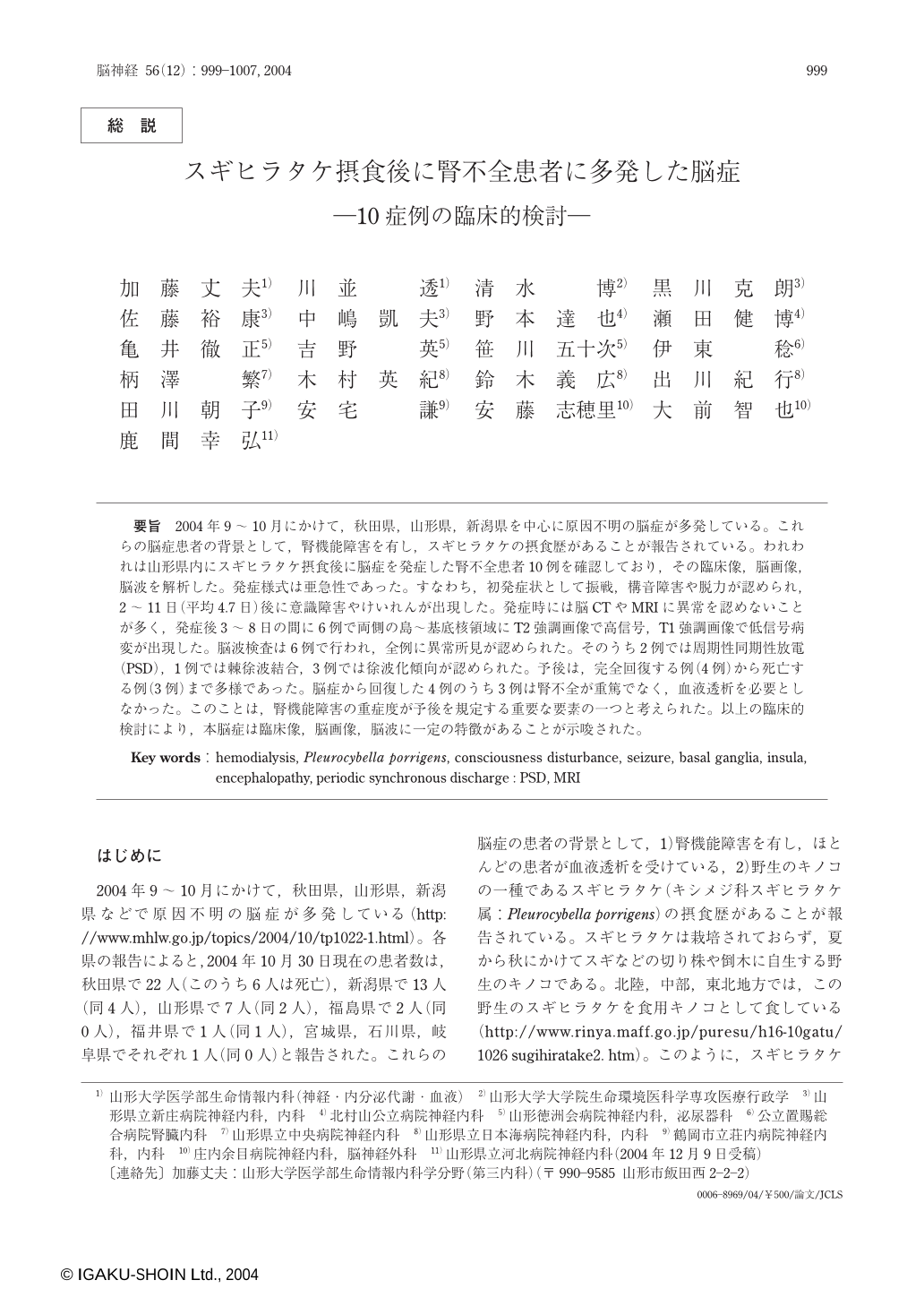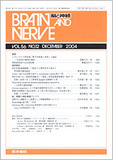Japanese
English
- 有料閲覧
- Abstract 文献概要
- 1ページ目 Look Inside
要旨 2004年9~10月にかけて,秋田県,山形県,新潟県を中心に原因不明の脳症が多発している。これらの脳症患者の背景として,腎機能障害を有し,スギヒラタケの摂食歴があることが報告されている。われわれは山形県内にスギヒラタケ摂食後に脳症を発症した腎不全患者10例を確認しており,その臨床像,脳画像,脳波を解析した。発症様式は亜急性であった。すなわち,初発症状として振戦,構音障害や脱力が認められ,2~11日(平均4.7日)後に意識障害やけいれんが出現した。発症時には脳CTやMRIに異常を認めないことが多く,発症後3~8日の間に6例で両側の島~基底核領域にT2強調画像で高信号,T1強調画像で低信号病変が出現した。脳波検査は6例で行われ,全例に異常所見が認められた。そのうち2例では周期性同期性放電(PSD),1例では棘徐波結合,3例では徐波化傾向が認められた。予後は,完全回復する例(4例)から死亡する例(3例)まで多様であった。脳症から回復した4例のうち3例は腎不全が重篤でなく,血液透析を必要としなかった。このことは,腎機能障害の重症度が予後を規定する重要な要素の一つと考えられた。以上の臨床的検討により,本脳症は臨床像,脳画像,脳波に一定の特徴があることが示唆された。
In September and October, 2004, an outbreak of encephalopathy of unknown etiology occurred in certain areas of Japan including Yamagata, Akita, and Niigata prefectures. These patients had a history of chronic renal failure, most of them had undergone hemodialysis, and also had a history of eating Sugihiratake(Pleurocybella porrigens), an autumn mushroom without known toxicity. Since clinical details of this type of encephalopathy remain unknown, we analyzed the clinical, radiological and electroencephalographic(EEG) features of ten cases of this encephalopathy in Yamagata prefecture. The summary of the present study is as follows :
1.Ten patients had chronic renal failure, and seven underwent hemodialysis.
2.Each patient had a history of eating Sugihiratake within 2-3 weeks of the onset of neurological symptoms.
3.The onset was subacute ; the initial symptoms were tremor, dysarthria, and/or weakness of the extremities, which lasted an average of 4.5 days(ranging from 2 to 11 days), followed by severe consciousness disturbance and intractable seizures, resulting in status epilepticus in 5 patients. Myoclonus was also seen in 4 patients and Babinski reflex in 3.
4.Brain CT and MRI examinations were unremarkable in the early stages of the disease. Three to eight days after onset, however,conspicuous lesions appeared in the areas of the insula and basal ganglia in 6 patients. On MRI, these brain lesions were hyperintense on T2-weighted and FLAIR images, and hypointense on T1-weighted images.
5.EEG examination was performed in 6 patients, all of whom showed abnormal EEG findings. Periodic synchronous discharge(PSD) was seen in 2 patients, spike and wave complex in one patient, and non-specific slow waves in 3.
6.Prognosis was different from case to case. Three patients died at 13, 14, and 29 days after onset. Two patients still showed persistent disturbance of consciousness one month after onset. One patient showed parkinsonism after recovering from consciousness disturbance. Four patients recovered nearly completely around one month after onset. In 3 of the 4 recovered patients, renal failure was not severe and they did not need to undergo hemodialysis. This suggests that the degree of renal failure is a key for the prognosis of this type of encephalopathy.
The present study suggests that this endemic disease is a newly recognized clinical entity of encephalopathy.(Received : December 9, 2004)

Copyright © 2004, Igaku-Shoin Ltd. All rights reserved.


